Australian Taxation Law Report: Net Income, FBT and Tax Implications
VerifiedAdded on 2020/12/30
|11
|3267
|274
Report
AI Summary
This report analyzes Australian taxation law, focusing on the determination of net income for a partnership and the implications of Fringe Benefits Tax (FBT). The report begins with an introduction to taxation and its application in Australia, including income tax and state taxes. It then delves into a specific case study, calculating the net income for a partnership for the year ended 30 June 2017. The analysis includes detailed calculations of business sales, cost of sales, gross profit, allowable and disallowed expenses, depreciation, and tax liability. Working papers are provided to support the calculations, including depreciation schedules and debtor/creditor accounts. The report also addresses FBT consequences, explaining the nature of FBT, its application to employee benefits, and the relevant legislation. The report concludes with a discussion of how employers should advise employees about FBT implications, including the benefits that can be provided and the tax implications for both the employer and employee. Finally, the report also includes a discussion on how fringe benefits are taxed and the role of FBT in retaining quality staff, and the importance of registering with FBT, keeping records, and reporting benefits on employee payment summaries.
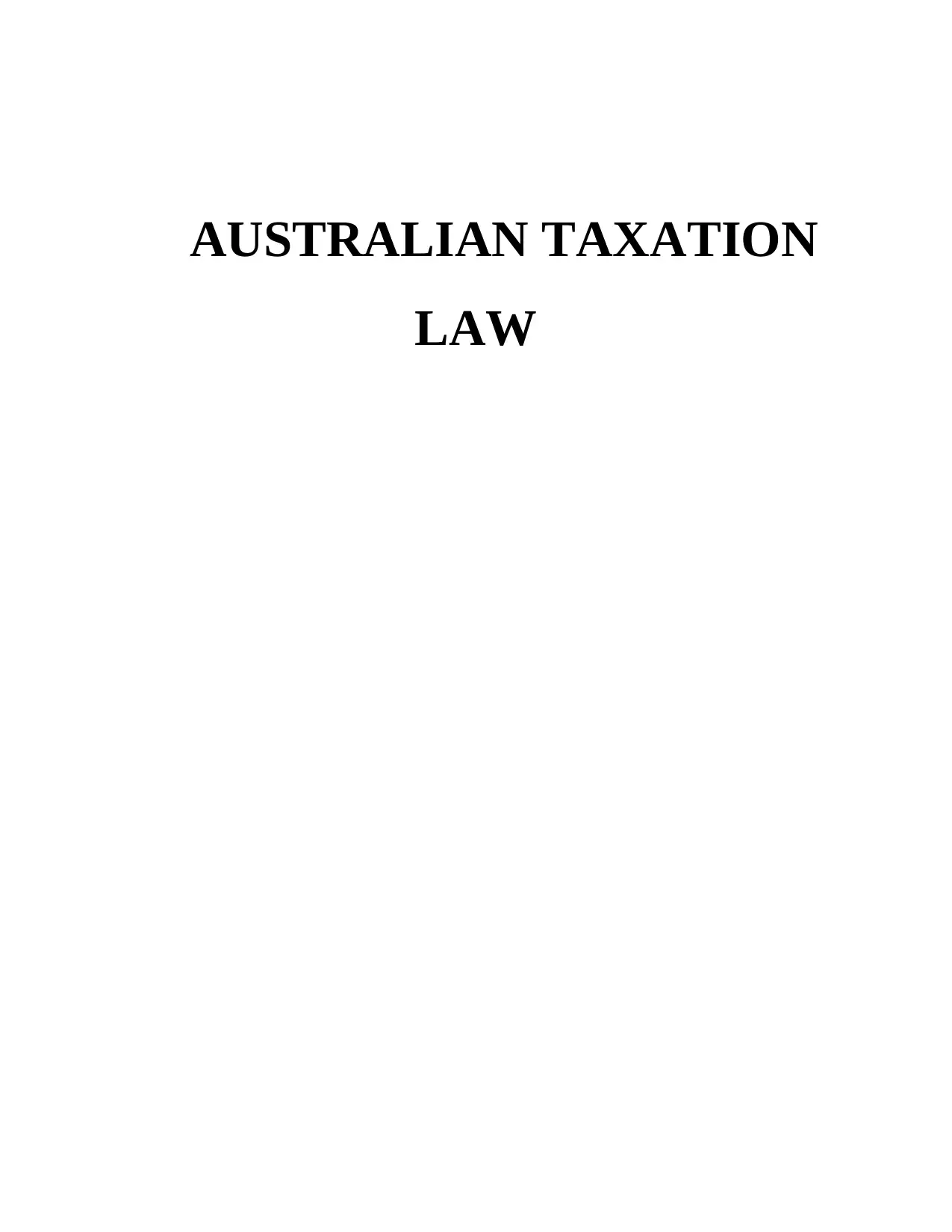
AUSTRALIAN TAXATION
LAW
LAW
Paraphrase This Document
Need a fresh take? Get an instant paraphrase of this document with our AI Paraphraser
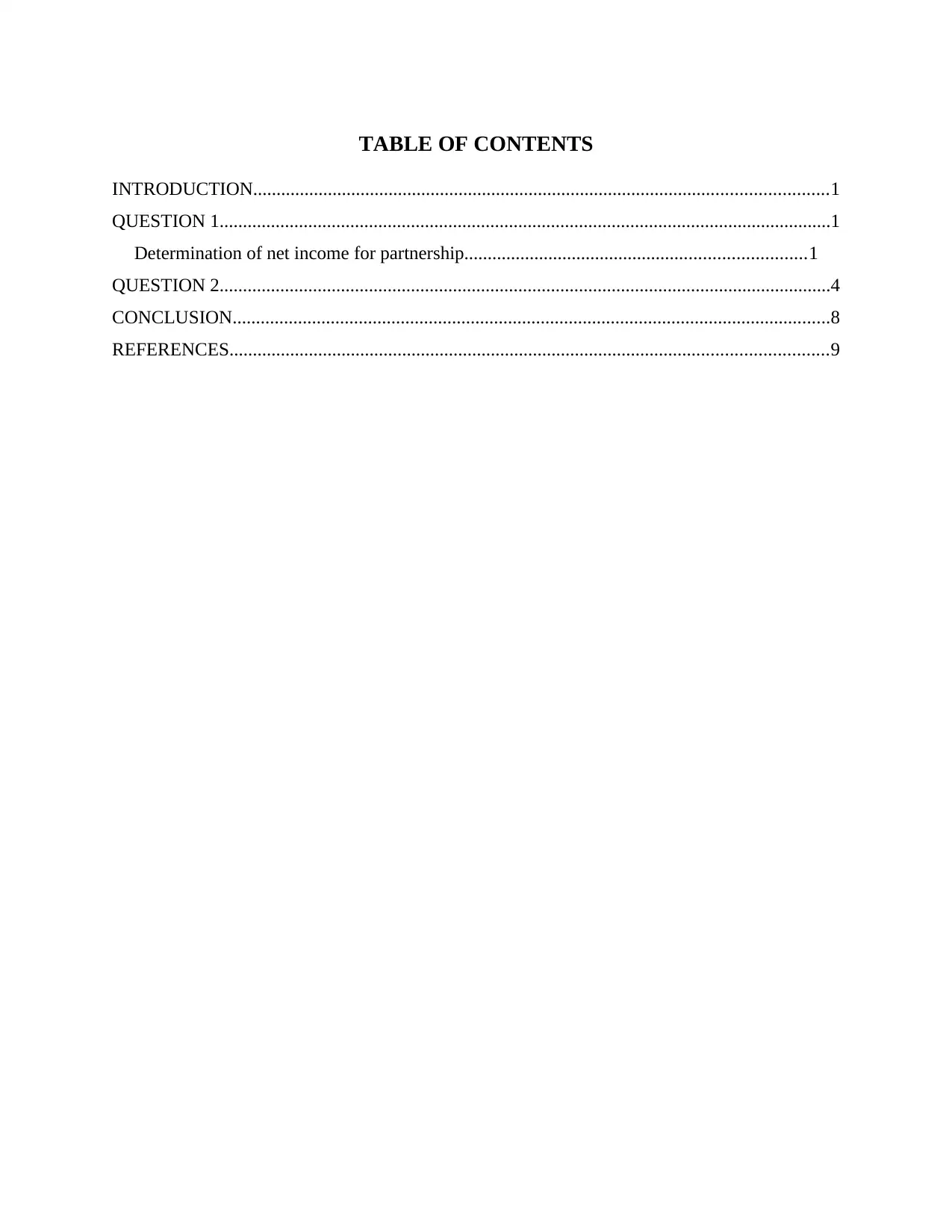
TABLE OF CONTENTS
INTRODUCTION...........................................................................................................................1
QUESTION 1...................................................................................................................................1
Determination of net income for partnership.........................................................................1
QUESTION 2...................................................................................................................................4
CONCLUSION................................................................................................................................8
REFERENCES................................................................................................................................9
INTRODUCTION...........................................................................................................................1
QUESTION 1...................................................................................................................................1
Determination of net income for partnership.........................................................................1
QUESTION 2...................................................................................................................................4
CONCLUSION................................................................................................................................8
REFERENCES................................................................................................................................9
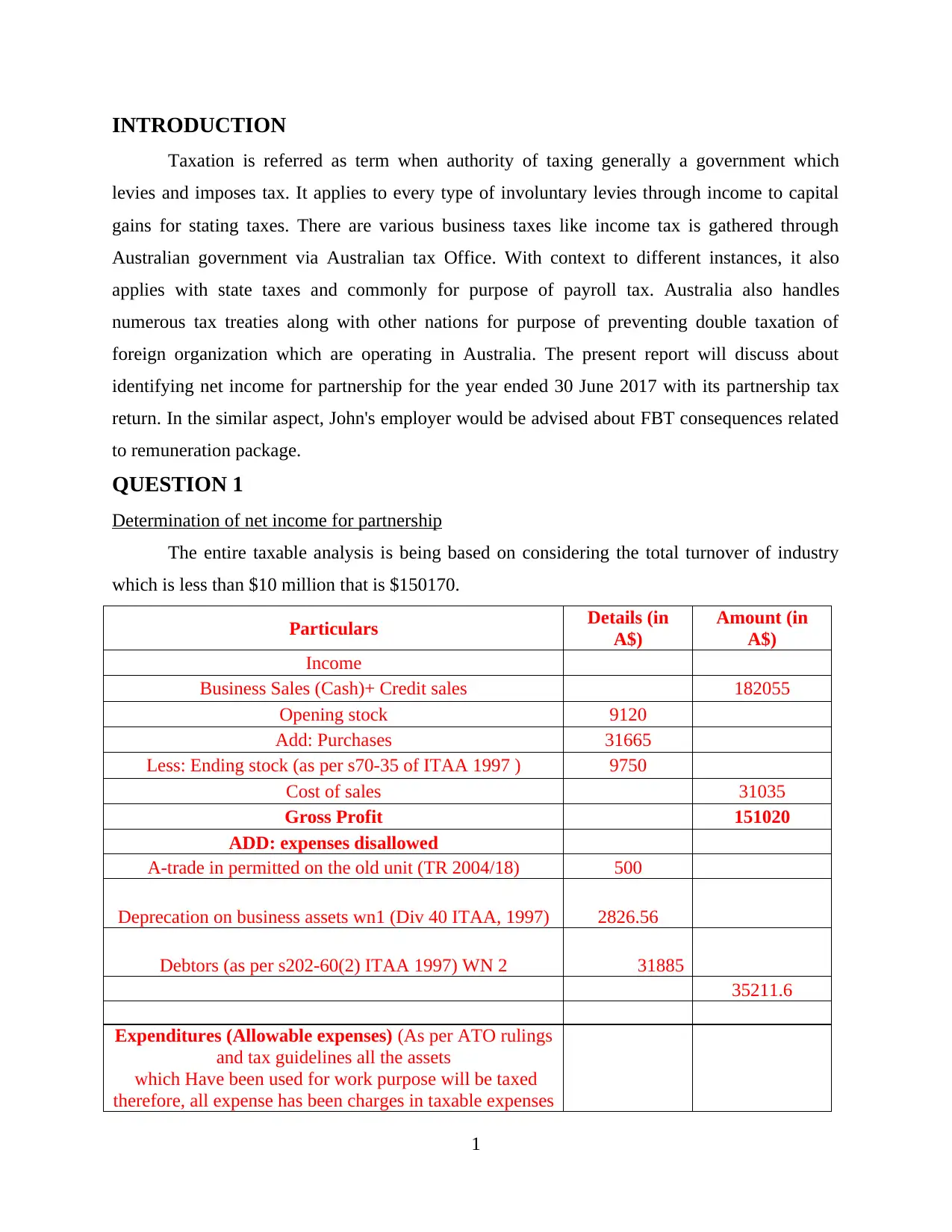
INTRODUCTION
Taxation is referred as term when authority of taxing generally a government which
levies and imposes tax. It applies to every type of involuntary levies through income to capital
gains for stating taxes. There are various business taxes like income tax is gathered through
Australian government via Australian tax Office. With context to different instances, it also
applies with state taxes and commonly for purpose of payroll tax. Australia also handles
numerous tax treaties along with other nations for purpose of preventing double taxation of
foreign organization which are operating in Australia. The present report will discuss about
identifying net income for partnership for the year ended 30 June 2017 with its partnership tax
return. In the similar aspect, John's employer would be advised about FBT consequences related
to remuneration package.
QUESTION 1
Determination of net income for partnership
The entire taxable analysis is being based on considering the total turnover of industry
which is less than $10 million that is $150170.
Particulars Details (in
A$)
Amount (in
A$)
Income
Business Sales (Cash)+ Credit sales 182055
Opening stock 9120
Add: Purchases 31665
Less: Ending stock (as per s70-35 of ITAA 1997 ) 9750
Cost of sales 31035
Gross Profit 151020
ADD: expenses disallowed
A-trade in permitted on the old unit (TR 2004/18) 500
Deprecation on business assets wn1 (Div 40 ITAA, 1997) 2826.56
Debtors (as per s202-60(2) ITAA 1997) WN 2 31885
35211.6
Expenditures (Allowable expenses) (As per ATO rulings
and tax guidelines all the assets
which Have been used for work purpose will be taxed
therefore, all expense has been charges in taxable expenses
1
Taxation is referred as term when authority of taxing generally a government which
levies and imposes tax. It applies to every type of involuntary levies through income to capital
gains for stating taxes. There are various business taxes like income tax is gathered through
Australian government via Australian tax Office. With context to different instances, it also
applies with state taxes and commonly for purpose of payroll tax. Australia also handles
numerous tax treaties along with other nations for purpose of preventing double taxation of
foreign organization which are operating in Australia. The present report will discuss about
identifying net income for partnership for the year ended 30 June 2017 with its partnership tax
return. In the similar aspect, John's employer would be advised about FBT consequences related
to remuneration package.
QUESTION 1
Determination of net income for partnership
The entire taxable analysis is being based on considering the total turnover of industry
which is less than $10 million that is $150170.
Particulars Details (in
A$)
Amount (in
A$)
Income
Business Sales (Cash)+ Credit sales 182055
Opening stock 9120
Add: Purchases 31665
Less: Ending stock (as per s70-35 of ITAA 1997 ) 9750
Cost of sales 31035
Gross Profit 151020
ADD: expenses disallowed
A-trade in permitted on the old unit (TR 2004/18) 500
Deprecation on business assets wn1 (Div 40 ITAA, 1997) 2826.56
Debtors (as per s202-60(2) ITAA 1997) WN 2 31885
35211.6
Expenditures (Allowable expenses) (As per ATO rulings
and tax guidelines all the assets
which Have been used for work purpose will be taxed
therefore, all expense has been charges in taxable expenses
1
⊘ This is a preview!⊘
Do you want full access?
Subscribe today to unlock all pages.

Trusted by 1+ million students worldwide
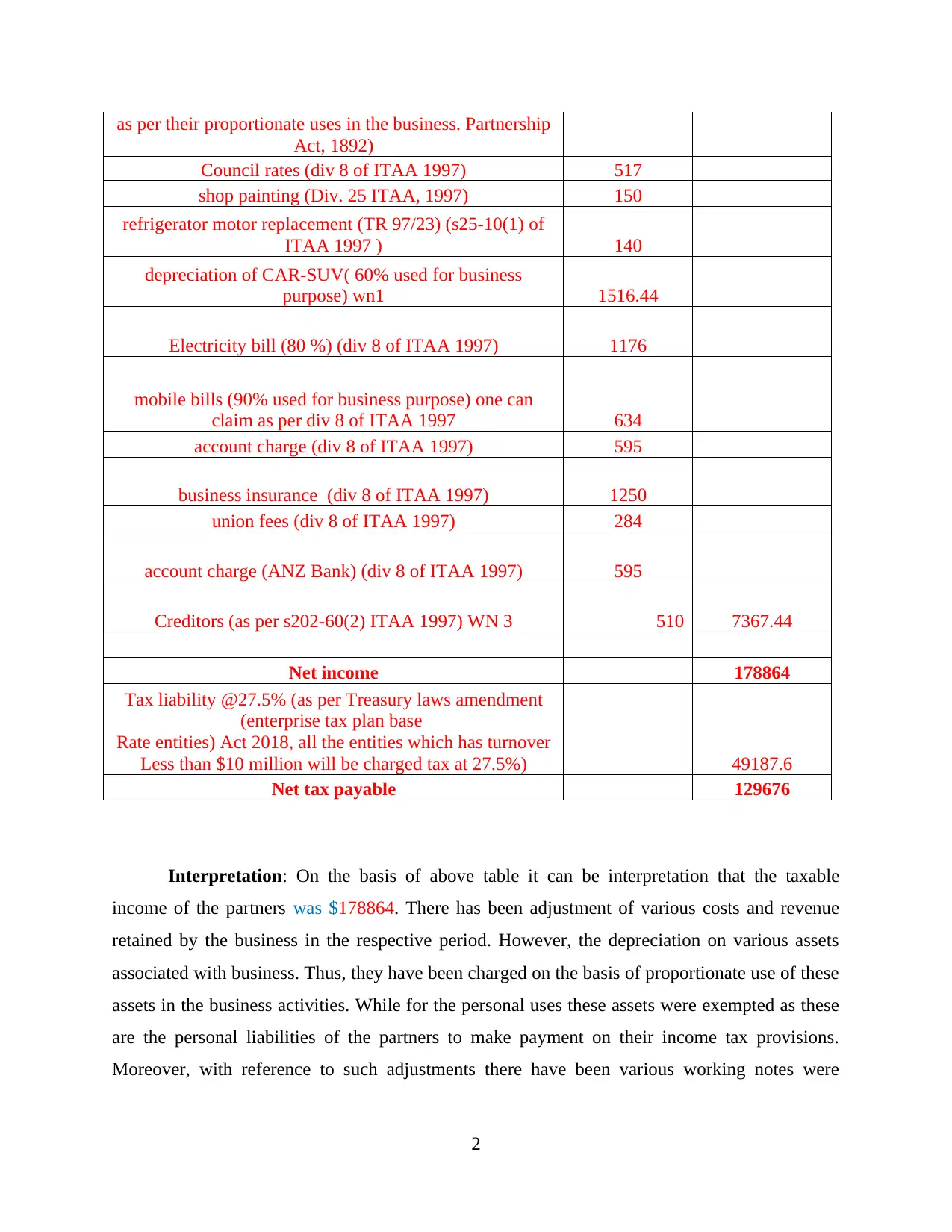
as per their proportionate uses in the business. Partnership
Act, 1892)
Council rates (div 8 of ITAA 1997) 517
shop painting (Div. 25 ITAA, 1997) 150
refrigerator motor replacement (TR 97/23) (s25-10(1) of
ITAA 1997 ) 140
depreciation of CAR-SUV( 60% used for business
purpose) wn1 1516.44
Electricity bill (80 %) (div 8 of ITAA 1997) 1176
mobile bills (90% used for business purpose) one can
claim as per div 8 of ITAA 1997 634
account charge (div 8 of ITAA 1997) 595
business insurance (div 8 of ITAA 1997) 1250
union fees (div 8 of ITAA 1997) 284
account charge (ANZ Bank) (div 8 of ITAA 1997) 595
Creditors (as per s202-60(2) ITAA 1997) WN 3 510 7367.44
Net income 178864
Tax liability @27.5% (as per Treasury laws amendment
(enterprise tax plan base
Rate entities) Act 2018, all the entities which has turnover
Less than $10 million will be charged tax at 27.5%) 49187.6
Net tax payable 129676
Interpretation: On the basis of above table it can be interpretation that the taxable
income of the partners was $178864. There has been adjustment of various costs and revenue
retained by the business in the respective period. However, the depreciation on various assets
associated with business. Thus, they have been charged on the basis of proportionate use of these
assets in the business activities. While for the personal uses these assets were exempted as these
are the personal liabilities of the partners to make payment on their income tax provisions.
Moreover, with reference to such adjustments there have been various working notes were
2
Act, 1892)
Council rates (div 8 of ITAA 1997) 517
shop painting (Div. 25 ITAA, 1997) 150
refrigerator motor replacement (TR 97/23) (s25-10(1) of
ITAA 1997 ) 140
depreciation of CAR-SUV( 60% used for business
purpose) wn1 1516.44
Electricity bill (80 %) (div 8 of ITAA 1997) 1176
mobile bills (90% used for business purpose) one can
claim as per div 8 of ITAA 1997 634
account charge (div 8 of ITAA 1997) 595
business insurance (div 8 of ITAA 1997) 1250
union fees (div 8 of ITAA 1997) 284
account charge (ANZ Bank) (div 8 of ITAA 1997) 595
Creditors (as per s202-60(2) ITAA 1997) WN 3 510 7367.44
Net income 178864
Tax liability @27.5% (as per Treasury laws amendment
(enterprise tax plan base
Rate entities) Act 2018, all the entities which has turnover
Less than $10 million will be charged tax at 27.5%) 49187.6
Net tax payable 129676
Interpretation: On the basis of above table it can be interpretation that the taxable
income of the partners was $178864. There has been adjustment of various costs and revenue
retained by the business in the respective period. However, the depreciation on various assets
associated with business. Thus, they have been charged on the basis of proportionate use of these
assets in the business activities. While for the personal uses these assets were exempted as these
are the personal liabilities of the partners to make payment on their income tax provisions.
Moreover, with reference to such adjustments there have been various working notes were
2
Paraphrase This Document
Need a fresh take? Get an instant paraphrase of this document with our AI Paraphraser
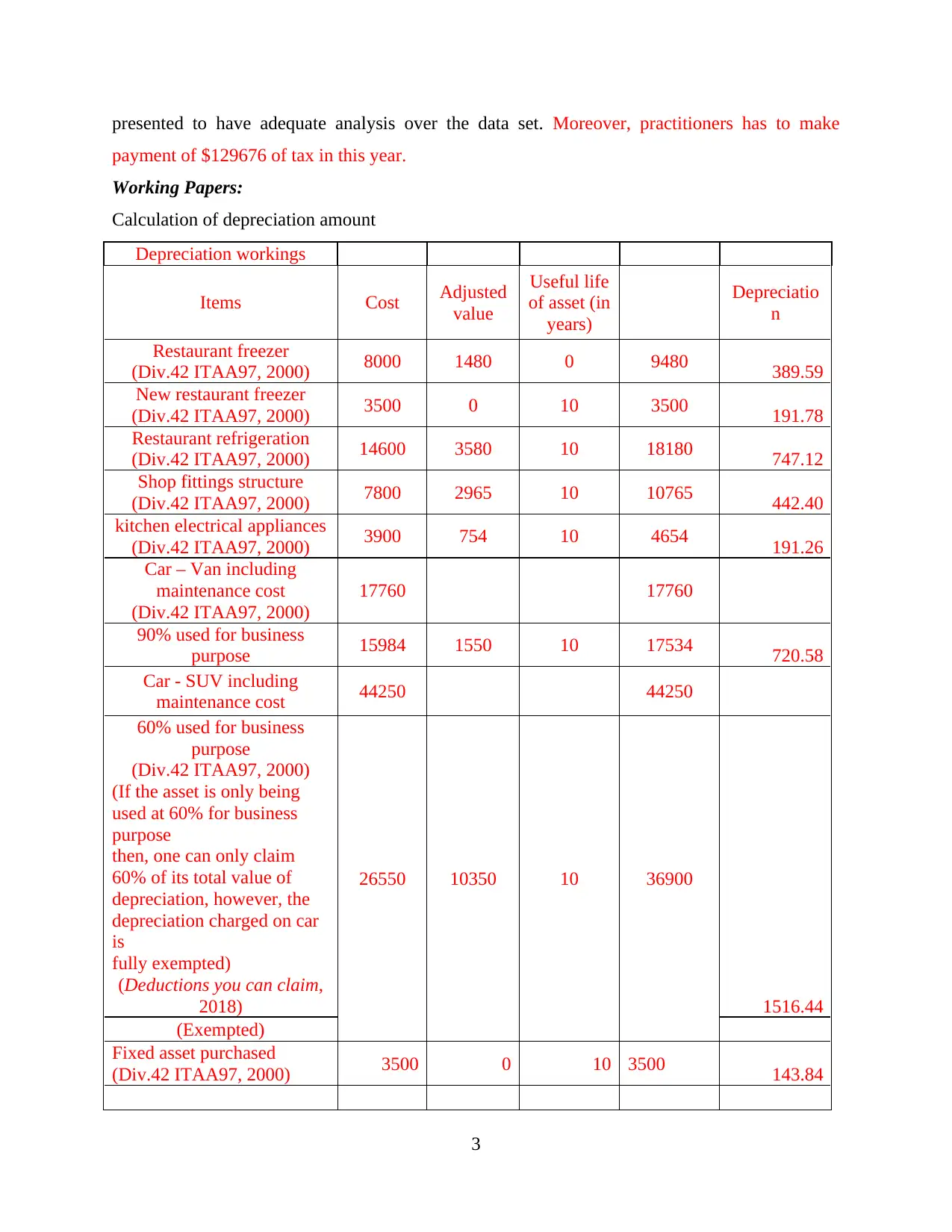
presented to have adequate analysis over the data set. Moreover, practitioners has to make
payment of $129676 of tax in this year.
Working Papers:
Calculation of depreciation amount
Depreciation workings
Items Cost Adjusted
value
Useful life
of asset (in
years)
Depreciatio
n
Restaurant freezer
(Div.42 ITAA97, 2000) 8000 1480 0 9480 389.59
New restaurant freezer
(Div.42 ITAA97, 2000) 3500 0 10 3500 191.78
Restaurant refrigeration
(Div.42 ITAA97, 2000) 14600 3580 10 18180 747.12
Shop fittings structure
(Div.42 ITAA97, 2000) 7800 2965 10 10765 442.40
kitchen electrical appliances
(Div.42 ITAA97, 2000) 3900 754 10 4654 191.26
Car – Van including
maintenance cost
(Div.42 ITAA97, 2000)
17760 17760
90% used for business
purpose 15984 1550 10 17534 720.58
Car - SUV including
maintenance cost 44250 44250
60% used for business
purpose
(Div.42 ITAA97, 2000)
(If the asset is only being
used at 60% for business
purpose
then, one can only claim
60% of its total value of
depreciation, however, the
depreciation charged on car
is
fully exempted)
(Deductions you can claim,
2018)
26550 10350 10 36900
1516.44
(Exempted)
Fixed asset purchased
(Div.42 ITAA97, 2000) 3500 0 10 3500 143.84
3
payment of $129676 of tax in this year.
Working Papers:
Calculation of depreciation amount
Depreciation workings
Items Cost Adjusted
value
Useful life
of asset (in
years)
Depreciatio
n
Restaurant freezer
(Div.42 ITAA97, 2000) 8000 1480 0 9480 389.59
New restaurant freezer
(Div.42 ITAA97, 2000) 3500 0 10 3500 191.78
Restaurant refrigeration
(Div.42 ITAA97, 2000) 14600 3580 10 18180 747.12
Shop fittings structure
(Div.42 ITAA97, 2000) 7800 2965 10 10765 442.40
kitchen electrical appliances
(Div.42 ITAA97, 2000) 3900 754 10 4654 191.26
Car – Van including
maintenance cost
(Div.42 ITAA97, 2000)
17760 17760
90% used for business
purpose 15984 1550 10 17534 720.58
Car - SUV including
maintenance cost 44250 44250
60% used for business
purpose
(Div.42 ITAA97, 2000)
(If the asset is only being
used at 60% for business
purpose
then, one can only claim
60% of its total value of
depreciation, however, the
depreciation charged on car
is
fully exempted)
(Deductions you can claim,
2018)
26550 10350 10 36900
1516.44
(Exempted)
Fixed asset purchased
(Div.42 ITAA97, 2000) 3500 0 10 3500 143.84
3
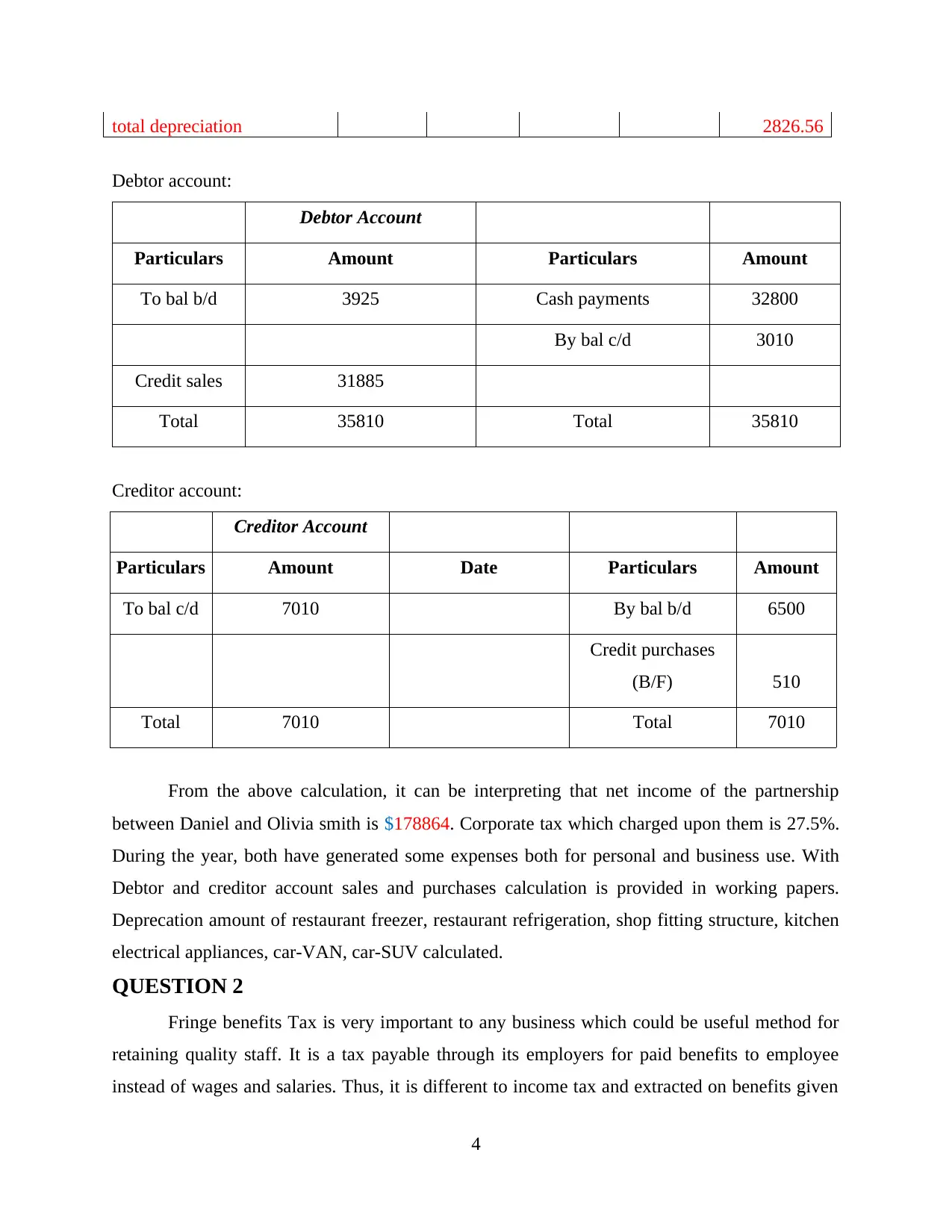
total depreciation 2826.56
Debtor account:
Debtor Account
Particulars Amount Particulars Amount
To bal b/d 3925 Cash payments 32800
By bal c/d 3010
Credit sales 31885
Total 35810 Total 35810
Creditor account:
Creditor Account
Particulars Amount Date Particulars Amount
To bal c/d 7010 By bal b/d 6500
Credit purchases
(B/F) 510
Total 7010 Total 7010
From the above calculation, it can be interpreting that net income of the partnership
between Daniel and Olivia smith is $178864. Corporate tax which charged upon them is 27.5%.
During the year, both have generated some expenses both for personal and business use. With
Debtor and creditor account sales and purchases calculation is provided in working papers.
Deprecation amount of restaurant freezer, restaurant refrigeration, shop fitting structure, kitchen
electrical appliances, car-VAN, car-SUV calculated.
QUESTION 2
Fringe benefits Tax is very important to any business which could be useful method for
retaining quality staff. It is a tax payable through its employers for paid benefits to employee
instead of wages and salaries. Thus, it is different to income tax and extracted on benefits given
4
Debtor account:
Debtor Account
Particulars Amount Particulars Amount
To bal b/d 3925 Cash payments 32800
By bal c/d 3010
Credit sales 31885
Total 35810 Total 35810
Creditor account:
Creditor Account
Particulars Amount Date Particulars Amount
To bal c/d 7010 By bal b/d 6500
Credit purchases
(B/F) 510
Total 7010 Total 7010
From the above calculation, it can be interpreting that net income of the partnership
between Daniel and Olivia smith is $178864. Corporate tax which charged upon them is 27.5%.
During the year, both have generated some expenses both for personal and business use. With
Debtor and creditor account sales and purchases calculation is provided in working papers.
Deprecation amount of restaurant freezer, restaurant refrigeration, shop fitting structure, kitchen
electrical appliances, car-VAN, car-SUV calculated.
QUESTION 2
Fringe benefits Tax is very important to any business which could be useful method for
retaining quality staff. It is a tax payable through its employers for paid benefits to employee
instead of wages and salaries. Thus, it is different to income tax and extracted on benefits given
4
⊘ This is a preview!⊘
Do you want full access?
Subscribe today to unlock all pages.

Trusted by 1+ million students worldwide
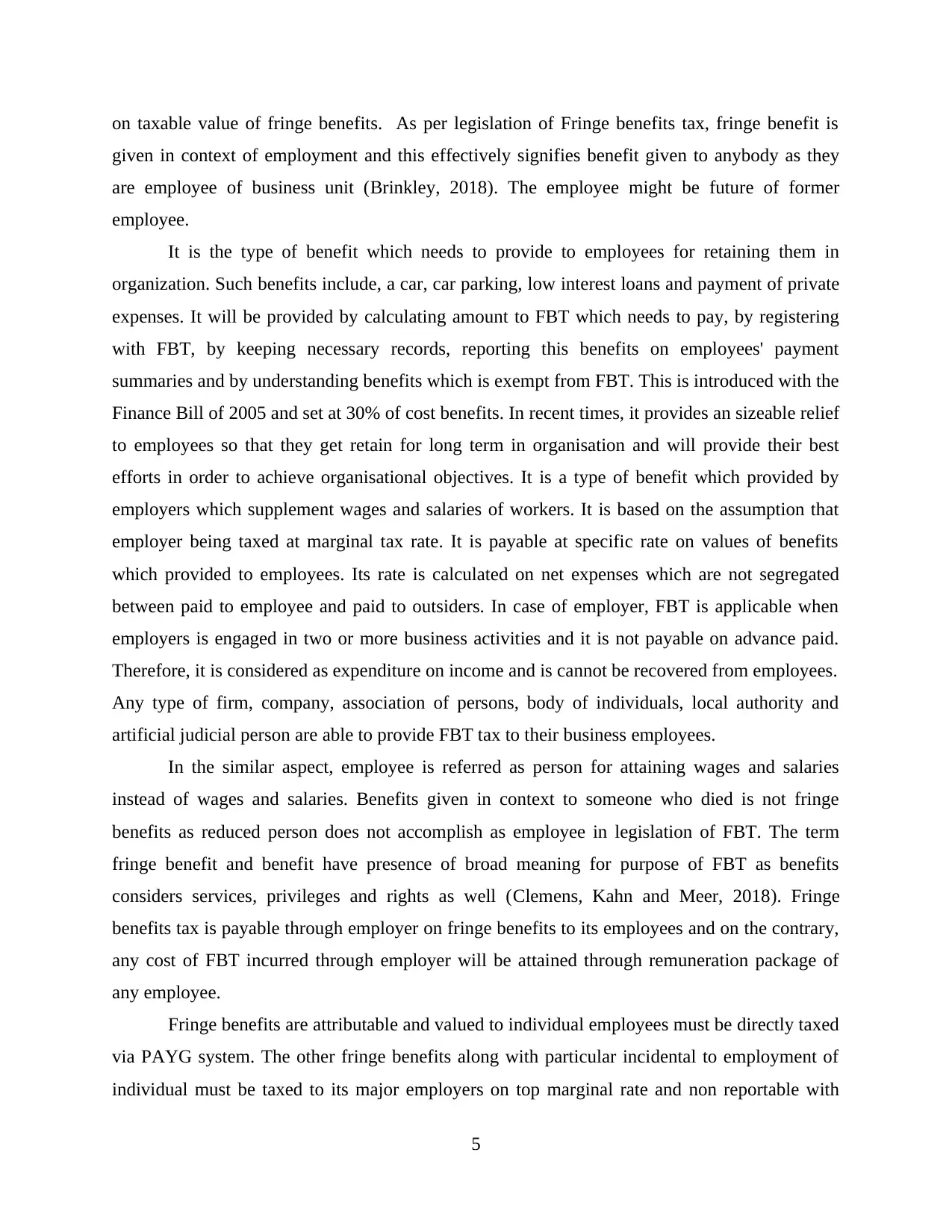
on taxable value of fringe benefits. As per legislation of Fringe benefits tax, fringe benefit is
given in context of employment and this effectively signifies benefit given to anybody as they
are employee of business unit (Brinkley, 2018). The employee might be future of former
employee.
It is the type of benefit which needs to provide to employees for retaining them in
organization. Such benefits include, a car, car parking, low interest loans and payment of private
expenses. It will be provided by calculating amount to FBT which needs to pay, by registering
with FBT, by keeping necessary records, reporting this benefits on employees' payment
summaries and by understanding benefits which is exempt from FBT. This is introduced with the
Finance Bill of 2005 and set at 30% of cost benefits. In recent times, it provides an sizeable relief
to employees so that they get retain for long term in organisation and will provide their best
efforts in order to achieve organisational objectives. It is a type of benefit which provided by
employers which supplement wages and salaries of workers. It is based on the assumption that
employer being taxed at marginal tax rate. It is payable at specific rate on values of benefits
which provided to employees. Its rate is calculated on net expenses which are not segregated
between paid to employee and paid to outsiders. In case of employer, FBT is applicable when
employers is engaged in two or more business activities and it is not payable on advance paid.
Therefore, it is considered as expenditure on income and is cannot be recovered from employees.
Any type of firm, company, association of persons, body of individuals, local authority and
artificial judicial person are able to provide FBT tax to their business employees.
In the similar aspect, employee is referred as person for attaining wages and salaries
instead of wages and salaries. Benefits given in context to someone who died is not fringe
benefits as reduced person does not accomplish as employee in legislation of FBT. The term
fringe benefit and benefit have presence of broad meaning for purpose of FBT as benefits
considers services, privileges and rights as well (Clemens, Kahn and Meer, 2018). Fringe
benefits tax is payable through employer on fringe benefits to its employees and on the contrary,
any cost of FBT incurred through employer will be attained through remuneration package of
any employee.
Fringe benefits are attributable and valued to individual employees must be directly taxed
via PAYG system. The other fringe benefits along with particular incidental to employment of
individual must be taxed to its major employers on top marginal rate and non reportable with
5
given in context of employment and this effectively signifies benefit given to anybody as they
are employee of business unit (Brinkley, 2018). The employee might be future of former
employee.
It is the type of benefit which needs to provide to employees for retaining them in
organization. Such benefits include, a car, car parking, low interest loans and payment of private
expenses. It will be provided by calculating amount to FBT which needs to pay, by registering
with FBT, by keeping necessary records, reporting this benefits on employees' payment
summaries and by understanding benefits which is exempt from FBT. This is introduced with the
Finance Bill of 2005 and set at 30% of cost benefits. In recent times, it provides an sizeable relief
to employees so that they get retain for long term in organisation and will provide their best
efforts in order to achieve organisational objectives. It is a type of benefit which provided by
employers which supplement wages and salaries of workers. It is based on the assumption that
employer being taxed at marginal tax rate. It is payable at specific rate on values of benefits
which provided to employees. Its rate is calculated on net expenses which are not segregated
between paid to employee and paid to outsiders. In case of employer, FBT is applicable when
employers is engaged in two or more business activities and it is not payable on advance paid.
Therefore, it is considered as expenditure on income and is cannot be recovered from employees.
Any type of firm, company, association of persons, body of individuals, local authority and
artificial judicial person are able to provide FBT tax to their business employees.
In the similar aspect, employee is referred as person for attaining wages and salaries
instead of wages and salaries. Benefits given in context to someone who died is not fringe
benefits as reduced person does not accomplish as employee in legislation of FBT. The term
fringe benefit and benefit have presence of broad meaning for purpose of FBT as benefits
considers services, privileges and rights as well (Clemens, Kahn and Meer, 2018). Fringe
benefits tax is payable through employer on fringe benefits to its employees and on the contrary,
any cost of FBT incurred through employer will be attained through remuneration package of
any employee.
Fringe benefits are attributable and valued to individual employees must be directly taxed
via PAYG system. The other fringe benefits along with particular incidental to employment of
individual must be taxed to its major employers on top marginal rate and non reportable with
5
Paraphrase This Document
Need a fresh take? Get an instant paraphrase of this document with our AI Paraphraser
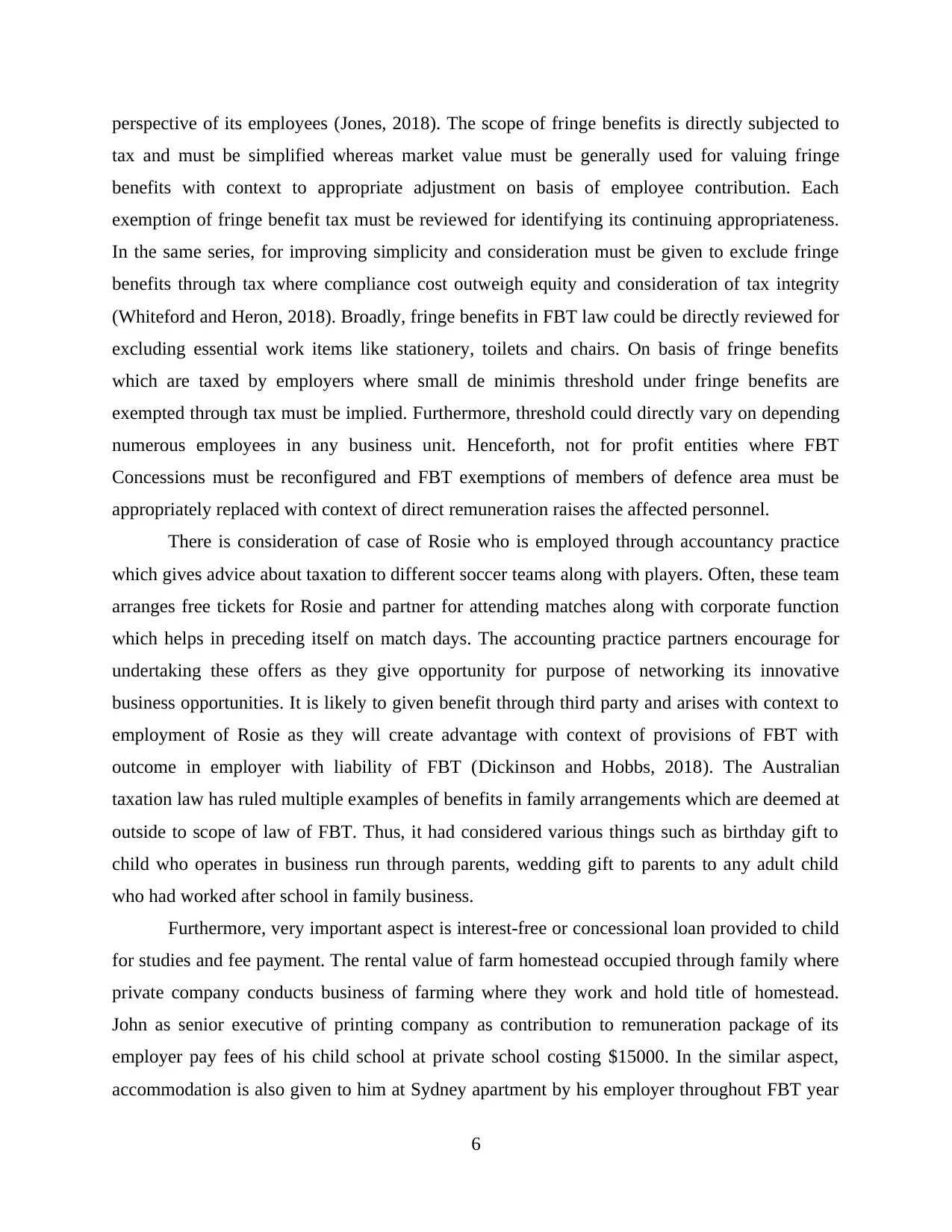
perspective of its employees (Jones, 2018). The scope of fringe benefits is directly subjected to
tax and must be simplified whereas market value must be generally used for valuing fringe
benefits with context to appropriate adjustment on basis of employee contribution. Each
exemption of fringe benefit tax must be reviewed for identifying its continuing appropriateness.
In the same series, for improving simplicity and consideration must be given to exclude fringe
benefits through tax where compliance cost outweigh equity and consideration of tax integrity
(Whiteford and Heron, 2018). Broadly, fringe benefits in FBT law could be directly reviewed for
excluding essential work items like stationery, toilets and chairs. On basis of fringe benefits
which are taxed by employers where small de minimis threshold under fringe benefits are
exempted through tax must be implied. Furthermore, threshold could directly vary on depending
numerous employees in any business unit. Henceforth, not for profit entities where FBT
Concessions must be reconfigured and FBT exemptions of members of defence area must be
appropriately replaced with context of direct remuneration raises the affected personnel.
There is consideration of case of Rosie who is employed through accountancy practice
which gives advice about taxation to different soccer teams along with players. Often, these team
arranges free tickets for Rosie and partner for attending matches along with corporate function
which helps in preceding itself on match days. The accounting practice partners encourage for
undertaking these offers as they give opportunity for purpose of networking its innovative
business opportunities. It is likely to given benefit through third party and arises with context to
employment of Rosie as they will create advantage with context of provisions of FBT with
outcome in employer with liability of FBT (Dickinson and Hobbs, 2018). The Australian
taxation law has ruled multiple examples of benefits in family arrangements which are deemed at
outside to scope of law of FBT. Thus, it had considered various things such as birthday gift to
child who operates in business run through parents, wedding gift to parents to any adult child
who had worked after school in family business.
Furthermore, very important aspect is interest-free or concessional loan provided to child
for studies and fee payment. The rental value of farm homestead occupied through family where
private company conducts business of farming where they work and hold title of homestead.
John as senior executive of printing company as contribution to remuneration package of its
employer pay fees of his child school at private school costing $15000. In the similar aspect,
accommodation is also given to him at Sydney apartment by his employer throughout FBT year
6
tax and must be simplified whereas market value must be generally used for valuing fringe
benefits with context to appropriate adjustment on basis of employee contribution. Each
exemption of fringe benefit tax must be reviewed for identifying its continuing appropriateness.
In the same series, for improving simplicity and consideration must be given to exclude fringe
benefits through tax where compliance cost outweigh equity and consideration of tax integrity
(Whiteford and Heron, 2018). Broadly, fringe benefits in FBT law could be directly reviewed for
excluding essential work items like stationery, toilets and chairs. On basis of fringe benefits
which are taxed by employers where small de minimis threshold under fringe benefits are
exempted through tax must be implied. Furthermore, threshold could directly vary on depending
numerous employees in any business unit. Henceforth, not for profit entities where FBT
Concessions must be reconfigured and FBT exemptions of members of defence area must be
appropriately replaced with context of direct remuneration raises the affected personnel.
There is consideration of case of Rosie who is employed through accountancy practice
which gives advice about taxation to different soccer teams along with players. Often, these team
arranges free tickets for Rosie and partner for attending matches along with corporate function
which helps in preceding itself on match days. The accounting practice partners encourage for
undertaking these offers as they give opportunity for purpose of networking its innovative
business opportunities. It is likely to given benefit through third party and arises with context to
employment of Rosie as they will create advantage with context of provisions of FBT with
outcome in employer with liability of FBT (Dickinson and Hobbs, 2018). The Australian
taxation law has ruled multiple examples of benefits in family arrangements which are deemed at
outside to scope of law of FBT. Thus, it had considered various things such as birthday gift to
child who operates in business run through parents, wedding gift to parents to any adult child
who had worked after school in family business.
Furthermore, very important aspect is interest-free or concessional loan provided to child
for studies and fee payment. The rental value of farm homestead occupied through family where
private company conducts business of farming where they work and hold title of homestead.
John as senior executive of printing company as contribution to remuneration package of its
employer pay fees of his child school at private school costing $15000. In the similar aspect,
accommodation is also given to him at Sydney apartment by his employer throughout FBT year
6
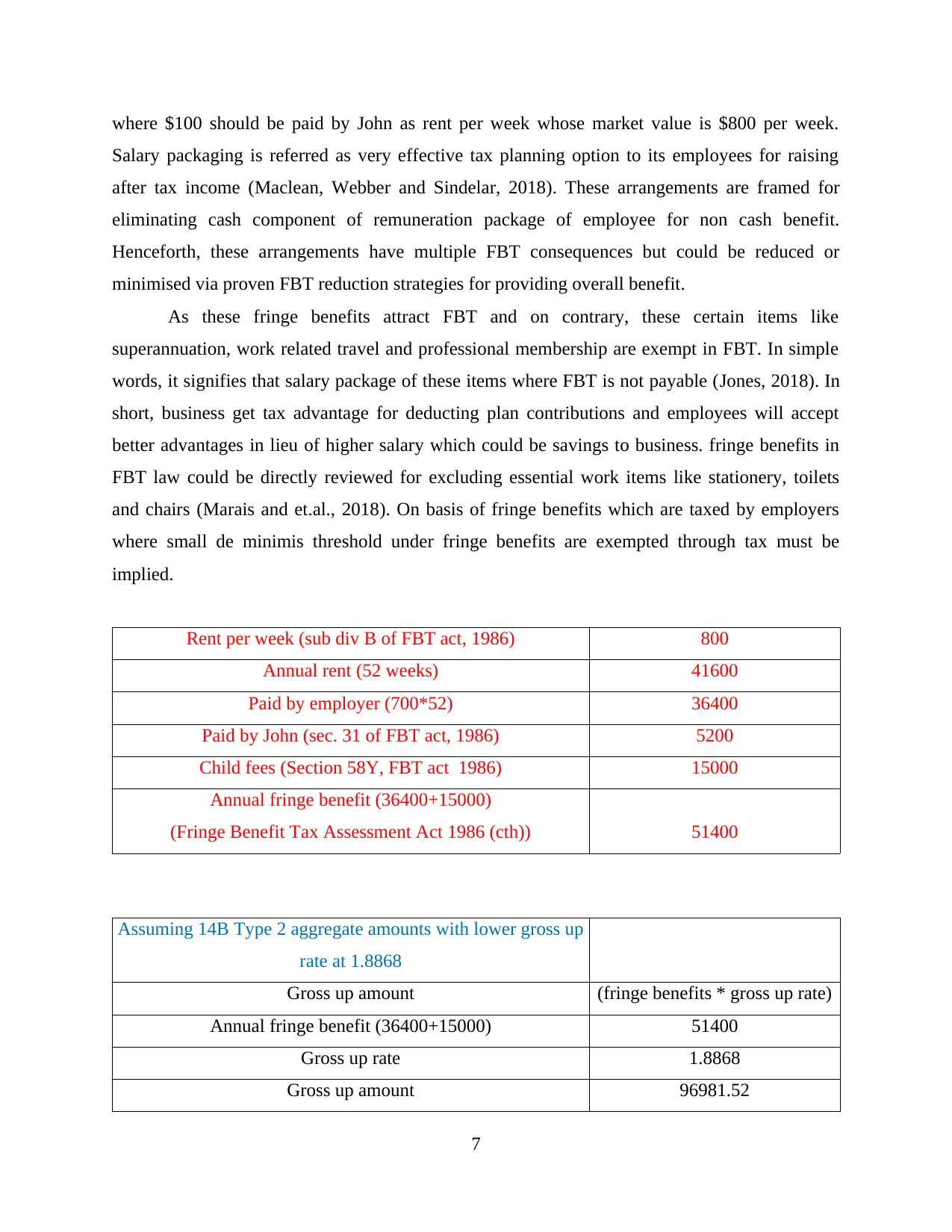
where $100 should be paid by John as rent per week whose market value is $800 per week.
Salary packaging is referred as very effective tax planning option to its employees for raising
after tax income (Maclean, Webber and Sindelar, 2018). These arrangements are framed for
eliminating cash component of remuneration package of employee for non cash benefit.
Henceforth, these arrangements have multiple FBT consequences but could be reduced or
minimised via proven FBT reduction strategies for providing overall benefit.
As these fringe benefits attract FBT and on contrary, these certain items like
superannuation, work related travel and professional membership are exempt in FBT. In simple
words, it signifies that salary package of these items where FBT is not payable (Jones, 2018). In
short, business get tax advantage for deducting plan contributions and employees will accept
better advantages in lieu of higher salary which could be savings to business. fringe benefits in
FBT law could be directly reviewed for excluding essential work items like stationery, toilets
and chairs (Marais and et.al., 2018). On basis of fringe benefits which are taxed by employers
where small de minimis threshold under fringe benefits are exempted through tax must be
implied.
Rent per week (sub div B of FBT act, 1986) 800
Annual rent (52 weeks) 41600
Paid by employer (700*52) 36400
Paid by John (sec. 31 of FBT act, 1986) 5200
Child fees (Section 58Y, FBT act 1986) 15000
Annual fringe benefit (36400+15000)
(Fringe Benefit Tax Assessment Act 1986 (cth)) 51400
Assuming 14B Type 2 aggregate amounts with lower gross up
rate at 1.8868
Gross up amount (fringe benefits * gross up rate)
Annual fringe benefit (36400+15000) 51400
Gross up rate 1.8868
Gross up amount 96981.52
7
Salary packaging is referred as very effective tax planning option to its employees for raising
after tax income (Maclean, Webber and Sindelar, 2018). These arrangements are framed for
eliminating cash component of remuneration package of employee for non cash benefit.
Henceforth, these arrangements have multiple FBT consequences but could be reduced or
minimised via proven FBT reduction strategies for providing overall benefit.
As these fringe benefits attract FBT and on contrary, these certain items like
superannuation, work related travel and professional membership are exempt in FBT. In simple
words, it signifies that salary package of these items where FBT is not payable (Jones, 2018). In
short, business get tax advantage for deducting plan contributions and employees will accept
better advantages in lieu of higher salary which could be savings to business. fringe benefits in
FBT law could be directly reviewed for excluding essential work items like stationery, toilets
and chairs (Marais and et.al., 2018). On basis of fringe benefits which are taxed by employers
where small de minimis threshold under fringe benefits are exempted through tax must be
implied.
Rent per week (sub div B of FBT act, 1986) 800
Annual rent (52 weeks) 41600
Paid by employer (700*52) 36400
Paid by John (sec. 31 of FBT act, 1986) 5200
Child fees (Section 58Y, FBT act 1986) 15000
Annual fringe benefit (36400+15000)
(Fringe Benefit Tax Assessment Act 1986 (cth)) 51400
Assuming 14B Type 2 aggregate amounts with lower gross up
rate at 1.8868
Gross up amount (fringe benefits * gross up rate)
Annual fringe benefit (36400+15000) 51400
Gross up rate 1.8868
Gross up amount 96981.52
7
⊘ This is a preview!⊘
Do you want full access?
Subscribe today to unlock all pages.

Trusted by 1+ million students worldwide
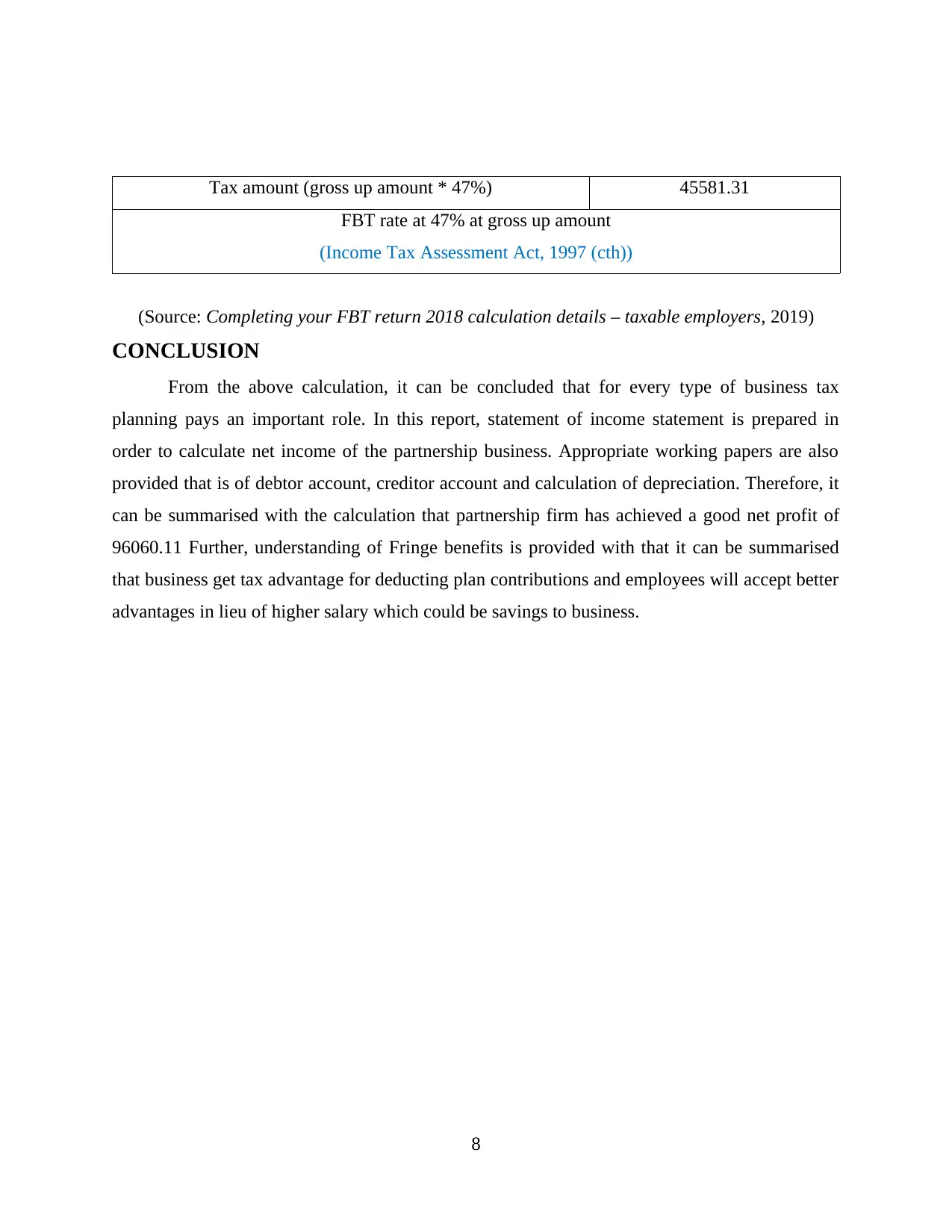
Tax amount (gross up amount * 47%) 45581.31
FBT rate at 47% at gross up amount
(Income Tax Assessment Act, 1997 (cth))
(Source: Completing your FBT return 2018 calculation details – taxable employers, 2019)
CONCLUSION
From the above calculation, it can be concluded that for every type of business tax
planning pays an important role. In this report, statement of income statement is prepared in
order to calculate net income of the partnership business. Appropriate working papers are also
provided that is of debtor account, creditor account and calculation of depreciation. Therefore, it
can be summarised with the calculation that partnership firm has achieved a good net profit of
96060.11 Further, understanding of Fringe benefits is provided with that it can be summarised
that business get tax advantage for deducting plan contributions and employees will accept better
advantages in lieu of higher salary which could be savings to business.
8
FBT rate at 47% at gross up amount
(Income Tax Assessment Act, 1997 (cth))
(Source: Completing your FBT return 2018 calculation details – taxable employers, 2019)
CONCLUSION
From the above calculation, it can be concluded that for every type of business tax
planning pays an important role. In this report, statement of income statement is prepared in
order to calculate net income of the partnership business. Appropriate working papers are also
provided that is of debtor account, creditor account and calculation of depreciation. Therefore, it
can be summarised with the calculation that partnership firm has achieved a good net profit of
96060.11 Further, understanding of Fringe benefits is provided with that it can be summarised
that business get tax advantage for deducting plan contributions and employees will accept better
advantages in lieu of higher salary which could be savings to business.
8
Paraphrase This Document
Need a fresh take? Get an instant paraphrase of this document with our AI Paraphraser
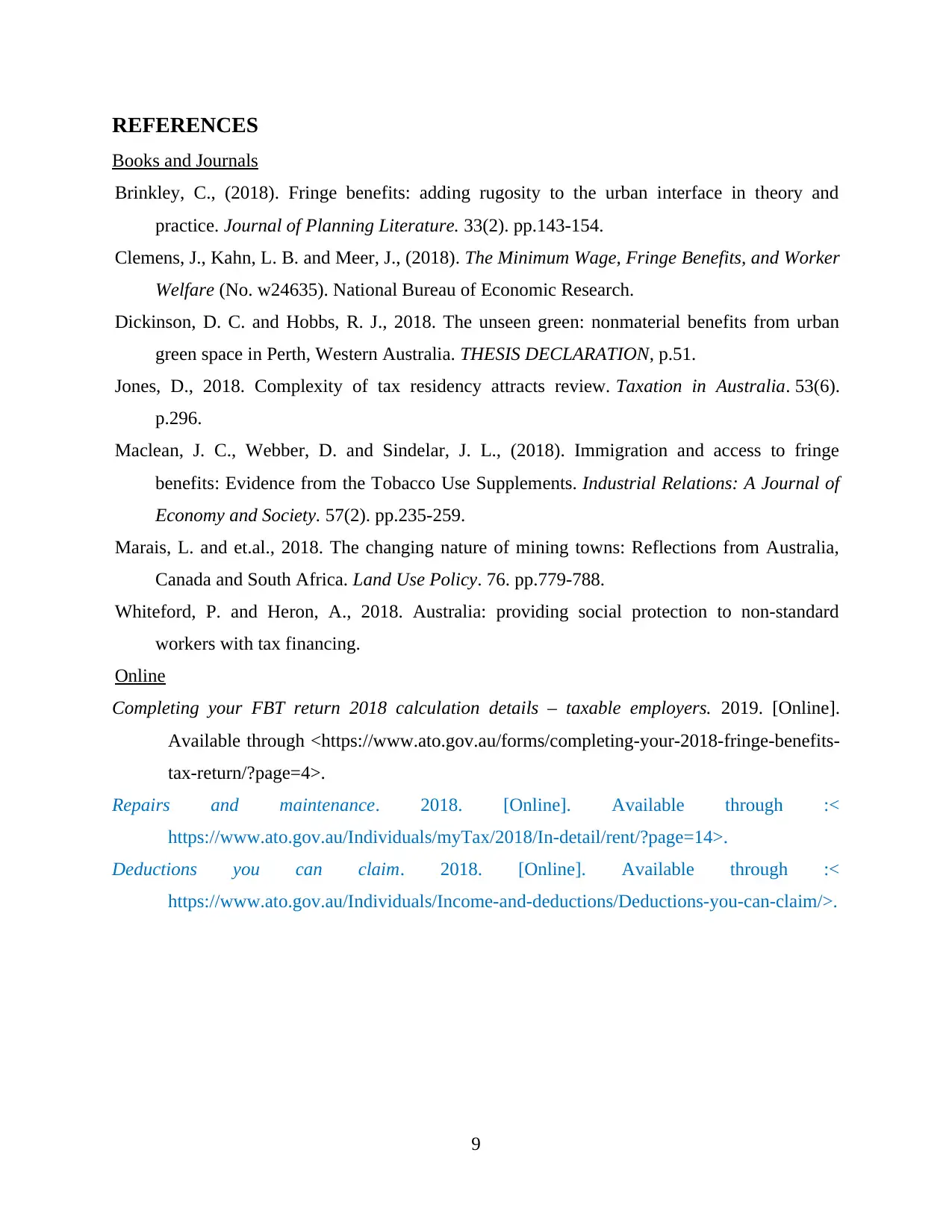
REFERENCES
Books and Journals
Brinkley, C., (2018). Fringe benefits: adding rugosity to the urban interface in theory and
practice. Journal of Planning Literature. 33(2). pp.143-154.
Clemens, J., Kahn, L. B. and Meer, J., (2018). The Minimum Wage, Fringe Benefits, and Worker
Welfare (No. w24635). National Bureau of Economic Research.
Dickinson, D. C. and Hobbs, R. J., 2018. The unseen green: nonmaterial benefits from urban
green space in Perth, Western Australia. THESIS DECLARATION, p.51.
Jones, D., 2018. Complexity of tax residency attracts review. Taxation in Australia. 53(6).
p.296.
Maclean, J. C., Webber, D. and Sindelar, J. L., (2018). Immigration and access to fringe
benefits: Evidence from the Tobacco Use Supplements. Industrial Relations: A Journal of
Economy and Society. 57(2). pp.235-259.
Marais, L. and et.al., 2018. The changing nature of mining towns: Reflections from Australia,
Canada and South Africa. Land Use Policy. 76. pp.779-788.
Whiteford, P. and Heron, A., 2018. Australia: providing social protection to non-standard
workers with tax financing.
Online
Completing your FBT return 2018 calculation details – taxable employers. 2019. [Online].
Available through <https://www.ato.gov.au/forms/completing-your-2018-fringe-benefits-
tax-return/?page=4>.
Repairs and maintenance. 2018. [Online]. Available through :<
https://www.ato.gov.au/Individuals/myTax/2018/In-detail/rent/?page=14>.
Deductions you can claim. 2018. [Online]. Available through :<
https://www.ato.gov.au/Individuals/Income-and-deductions/Deductions-you-can-claim/>.
9
Books and Journals
Brinkley, C., (2018). Fringe benefits: adding rugosity to the urban interface in theory and
practice. Journal of Planning Literature. 33(2). pp.143-154.
Clemens, J., Kahn, L. B. and Meer, J., (2018). The Minimum Wage, Fringe Benefits, and Worker
Welfare (No. w24635). National Bureau of Economic Research.
Dickinson, D. C. and Hobbs, R. J., 2018. The unseen green: nonmaterial benefits from urban
green space in Perth, Western Australia. THESIS DECLARATION, p.51.
Jones, D., 2018. Complexity of tax residency attracts review. Taxation in Australia. 53(6).
p.296.
Maclean, J. C., Webber, D. and Sindelar, J. L., (2018). Immigration and access to fringe
benefits: Evidence from the Tobacco Use Supplements. Industrial Relations: A Journal of
Economy and Society. 57(2). pp.235-259.
Marais, L. and et.al., 2018. The changing nature of mining towns: Reflections from Australia,
Canada and South Africa. Land Use Policy. 76. pp.779-788.
Whiteford, P. and Heron, A., 2018. Australia: providing social protection to non-standard
workers with tax financing.
Online
Completing your FBT return 2018 calculation details – taxable employers. 2019. [Online].
Available through <https://www.ato.gov.au/forms/completing-your-2018-fringe-benefits-
tax-return/?page=4>.
Repairs and maintenance. 2018. [Online]. Available through :<
https://www.ato.gov.au/Individuals/myTax/2018/In-detail/rent/?page=14>.
Deductions you can claim. 2018. [Online]. Available through :<
https://www.ato.gov.au/Individuals/Income-and-deductions/Deductions-you-can-claim/>.
9
1 out of 11
Related Documents
Your All-in-One AI-Powered Toolkit for Academic Success.
+13062052269
info@desklib.com
Available 24*7 on WhatsApp / Email
![[object Object]](/_next/static/media/star-bottom.7253800d.svg)
Unlock your academic potential
Copyright © 2020–2025 A2Z Services. All Rights Reserved. Developed and managed by ZUCOL.





